Related Research Articles
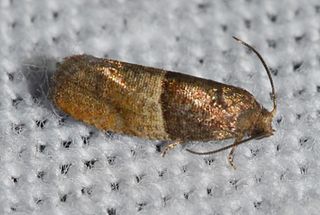
Larisa is a genus of moths belonging to the subfamily Olethreutinae of the family Tortricidae. It contains only one species, Larisa subsolana, which is found in North America, where it has been recorded from Alabama, Florida, Georgia, Illinois, Indiana, Kentucky, Maine, Maryland, Massachusetts, Minnesota, Mississippi, Missouri, New York, Ohio, Oklahoma, Ontario, Quebec, South Carolina, Tennessee, Texas, Virginia and West Virginia.
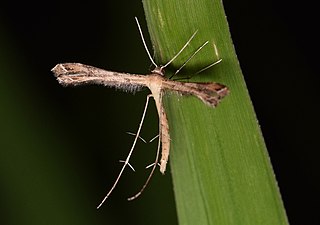
Stenoptilodes taprobanes is a moth of the family Pterophoridae. This species has a pantropical distribution, which extends into subtropical areas.
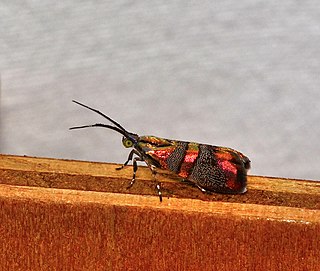
Tortyra slossonia, commonly known as the reflective tortyra moth, ficus budworm or Slosson's metalmark moth, is a moth of the family Choreutidae. It is known from Florida.
Tortyra iocyaneus is a moth of the family Choreutidae. It is known from Florida, United States.

Nomophila nearctica, the lucerne moth, clover nomophila, false webworm, celery stalkworm or American celery webworm, is a moth of the family Crambidae. It is known from southern Canada and all of the United States, south to Mexico and the Neotropics.
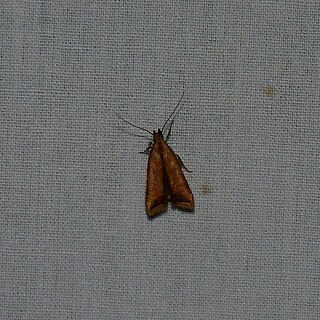
The black-edged dichomeris or black-edged carbatina is a moth of the family Gelechiidae. It is found in the north-eastern United States, Korea, Japan, China, Taiwan and India. It has also been recorded in the Netherlands, where it is an exotic species.

Epipaschia superatalis, the dimorphic macalla moth, is a moth in the family Pyralidae. It is found in eastern North America.
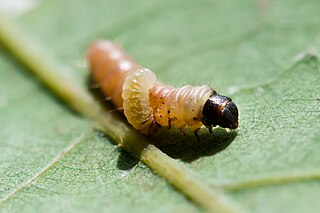
Psilocorsis cryptolechiella is a moth of the family Depressariidae. It is found in the United States, including Alabama, Illinois, Massachusetts, Pennsylvania and South Carolina.
Evergestis rimosalis, the cross-striped cabbageworm, is a moth of the family Crambidae. It is found in most of the eastern United States.

Diaphania hyalinata, the melonworm moth, is a moth of the family Crambidae. It is found in eastern North America, south to Central and South America and the Caribbean.

Epinotia trigonella, the birch epinotia moth, is a species of moth of the family Tortricidae. It is found in most of Europe, east to the eastern Palearctic realm. It is also found in North America.
Basacallis is a monotypic snout moth genus. It was described by Everett D. Cashatt in 1969, and contains the species Basacallis tarachodes. It is found in Panama, Florida, Mississippi, Alabama, and South Carolina.
Cabnia is a monotypic snout moth genus described by Harrison Gray Dyar Jr. in 1904. Its only member, C. myronella, is found in the United States from Massachusetts to Florida and Mississippi.
Diviana is a genus of snout moths. It was described by Ragonot in 1888, and contains the species D. eudoreella. It is found in the southern United States.

Acrobasis caryae, the hickory shoot borer, is a species of snout moth in the genus Acrobasis. It was described by Augustus Radcliffe Grote in 1881, and is known from southeastern Ontario, Canada, and the eastern United States.
Ambesa walsinghami is a species of snout moth in the genus Ambesa. It was described by Ragonot in 1887. It is found in the western North America.

Acrobasis caliginella is a species of snout moth in the genus Acrobasis. It was described by George Duryea Hulst in 1878. It is found in the US states of California and Arizona.

Hedya ochroleucana, the buff-tipped marble or long-cloaked marble, is a moth of the family Tortricidae. It is found in most of Europe, except part of the Balkan Peninsula and Ukraine. It is also present in most of North America.

Nemapogon clematella, the barred white clothes moth, is a moth of the family Tineidae. It is found in most of Europe and in North America, where it has been recorded from Maryland and North Carolina. The habitat consists of woodlands.
Coleotechnites canusella, the banded jack-pine needleminer moth, is a moth of the family Gelechiidae. It is found in North America, where it has been recorded from British Columbia, Washington, Alabama, Arizona, Louisiana, New Mexico and South Carolina.
References
- ↑ "GlobIZ search". Global Information System on Pyraloidea. Retrieved 2011-09-29.
- ↑ "mothphotographersgroup". Mothphotographersgroup.msstate.edu. Retrieved 2012-01-17.
| This Phycitinae-related article is a stub. You can help Wikipedia by expanding it. |